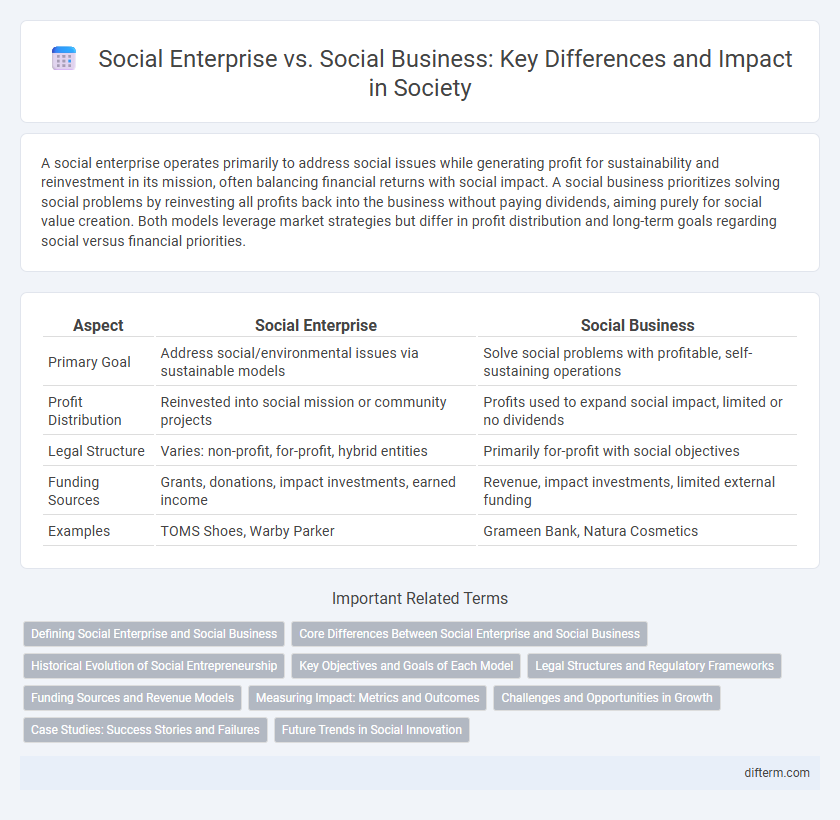A social enterprise operates primarily to address social issues while generating profit for sustainability and reinvestment in its mission, often balancing financial returns with social impact. A social business prioritizes solving social problems by reinvesting all profits back into the business without paying dividends, aiming purely for social value creation. Both models leverage market strategies but differ in profit distribution and long-term goals regarding social versus financial priorities.
Table of Comparison
| Aspect | Social Enterprise | Social Business |
|---|---|---|
| Primary Goal | Address social/environmental issues via sustainable models | Solve social problems with profitable, self-sustaining operations |
| Profit Distribution | Reinvested into social mission or community projects | Profits used to expand social impact, limited or no dividends |
| Legal Structure | Varies: non-profit, for-profit, hybrid entities | Primarily for-profit with social objectives |
| Funding Sources | Grants, donations, impact investments, earned income | Revenue, impact investments, limited external funding |
| Examples | TOMS Shoes, Warby Parker | Grameen Bank, Natura Cosmetics |
Defining Social Enterprise and Social Business
Social enterprises prioritize solving social or environmental issues through business models that reinvest profits to amplify community impact. Social businesses operate with a self-sustaining approach, focusing on addressing specific social problems while maintaining financial viability without profit distribution to owners. Both integrate social goals with entrepreneurial strategies, yet social enterprises often blend profit motives with nonprofit elements, whereas social businesses strictly reinvest earnings to expand their mission-driven activities.
Core Differences Between Social Enterprise and Social Business
Social enterprises focus on addressing social issues through sustainable business models that reinvest profits into community projects and social initiatives, emphasizing measurable social impact alongside financial viability. Social businesses prioritize solving specific social problems by operating as non-loss, non-dividend companies where profits are solely used to expand the mission without distributing dividends to investors. The core difference lies in the profit allocation and reinvestment strategy, with social enterprises balancing profit generation and social goals, whereas social businesses operate primarily to achieve social objectives without profit distribution.
Historical Evolution of Social Entrepreneurship
Social enterprises originated in the 19th century as charitable organizations merging business principles with social missions, focusing on sustainable impact. The concept evolved in the late 20th century with the rise of social businesses, pioneered notably by Muhammad Yunus, emphasizing innovative market-based solutions for poverty alleviation. This historical evolution reflects a shift from traditional philanthropy to integrated economic and social value creation within entrepreneurial models.
Key Objectives and Goals of Each Model
Social enterprises primarily focus on achieving social impact through sustainable business models that balance profit generation with community benefits, aiming to reinvest profits into social causes. Social businesses emphasize solving specific social problems by operating on a non-loss, non-dividend basis, prioritizing social objectives over profit maximization. Both models prioritize societal well-being, but social enterprises integrate profitability with social missions, while social businesses concentrate on addressing social issues without financial gain distribution.
Legal Structures and Regulatory Frameworks
Social enterprises typically operate under legal structures such as benefit corporations, community interest companies, or nonprofit organizations, which mandate specific social or environmental goals alongside profit motives. Social businesses often adopt conventional business forms, like limited liability companies or sole proprietorships, but incorporate social objectives within their business models without requiring separate legal recognition. Regulatory frameworks for social enterprises usually involve compliance with transparency, impact reporting, and reinvestment of profits, while social businesses adhere primarily to commercial laws with voluntary social impact commitments.
Funding Sources and Revenue Models
Social enterprises typically secure funding through grants, philanthropic donations, and impact investments, blending revenue generation with social impact goals. Social businesses rely primarily on earned income from sales and services directly linked to their mission, focusing on sustainable, market-driven revenue models. Both structures emphasize reinvesting profits into social causes, but social enterprises often require diversified funding to scale impact.
Measuring Impact: Metrics and Outcomes
Measuring impact in social enterprises typically involves assessing social return on investment (SROI) and community engagement levels to evaluate long-term benefits. Social businesses prioritize metrics such as financial sustainability paired with social outcomes like job creation and environmental improvements. Both models rely on qualitative and quantitative data to track progress, but social enterprises often emphasize broader systemic change over immediate profit-driven results.
Challenges and Opportunities in Growth
Social enterprises face challenges in scaling impact due to limited access to capital and balancing social goals with financial sustainability, while social businesses often struggle with market competitiveness and stakeholder alignment. Opportunities in growth for both include leveraging technology for broader reach, forming strategic partnerships, and impact investing to enhance resource mobilization. Successfully navigating regulatory frameworks and measuring social impact can differentiate social enterprises and social businesses in attracting funding and customer loyalty.
Case Studies: Success Stories and Failures
Social enterprises like TOMS Shoes have successfully combined profit with purpose by implementing a one-for-one giving model, demonstrating scalability and lasting social impact, while social businesses such as Grameen Bank illustrate success through sustainable microfinance solutions fostering community development. Conversely, some ventures under both models face challenges; for example, Social Business Trust encountered funding constraints that limited project expansion, highlighting the importance of financial resilience and strategic partnerships. Analyzing these case studies emphasizes that the viability of social impact initiatives depends on adaptive management and alignment with local socio-economic contexts.
Future Trends in Social Innovation
Social enterprises and social businesses are increasingly leveraging digital technologies and data analytics to enhance impact measurement and scalability, driving the future of social innovation. Emerging trends emphasize collaborative ecosystems, blending profit motives with social value creation to attract hybrid funding models. Advancements in blockchain for transparency and AI for personalized interventions are setting new standards for accountability and effectiveness in addressing complex social challenges.
social enterprise vs social business Infographic

 difterm.com
difterm.com